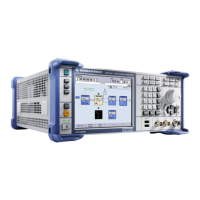Instrument Function
R&S
®
SMBV100A
344Operating Manual 1176.8016.02 ─ 17
however assigned to the individual modulation symbols. The following tables show the
assignment of modulation symbols to phase shifts of the I/Q vector in relation to the
selected coding.
Table 5-4: Phase shifts for pi/4DQPSK
Modulation symbol a
n
(binary indication: MSB, LSB)
00 01 10 11
Phase shifts without coding + 45° + 135° - 135° - 45°
Phase shifts with coding NADC, PDC, PHS,
TETRA or APCO25 (PSK)
+ 45° + 135° - 45° - 135°
Phase shifts with coding TFTS - 135° + 135° - 45° + 45°
Coding algorithms
Common coding types are listed in the following table.
Table 5-5: Coding algorithms
Coding Coding algorithm Applicable for K bit/symbol
NONE b
n
= a
n
k = 1...8
Differential
b
n
= (a
n
+ b
n-1
) modulo 2
k
k = 1...7
Differential + Gray Gray coding with additional differ-
ential coding
k = 1...7
GSM dc
n
= not (d
n
exor d
n-1
) k = 1
Example: Differential coding for QPSK modulation with K = 2 bit/symbol
Decimal display; value range for modulation symbols
Recursive coding is defined as follows: b
n
= (a
n
+ b
n-1
) modulo 4
Depending on the state of a preceding modulation symbol b
n-1
the coded modulation
symbol b
n
is obtained for example from modulation symbol a
n
= 2 as follows:
a
n
= 2 b
n-1
b
n
0 2
1 3
Baseband Signal - Baseband Block

